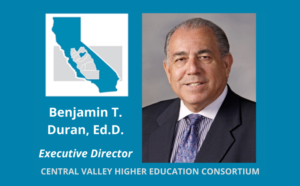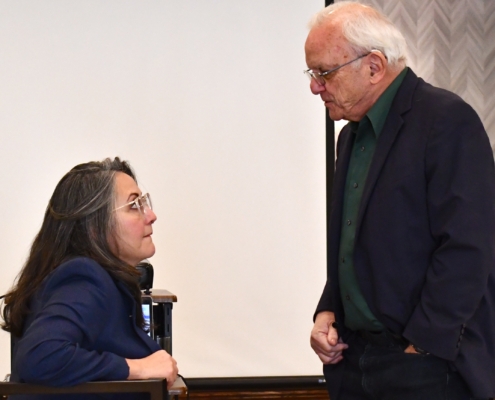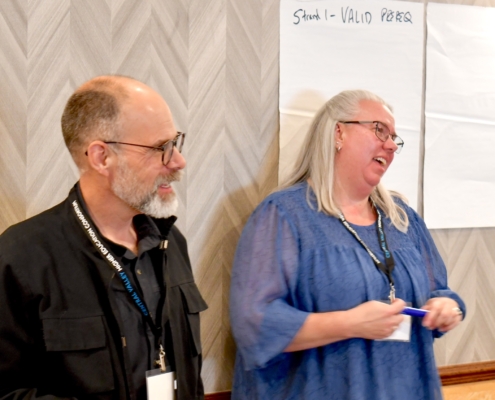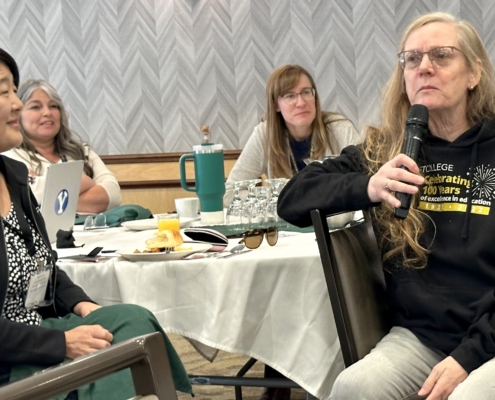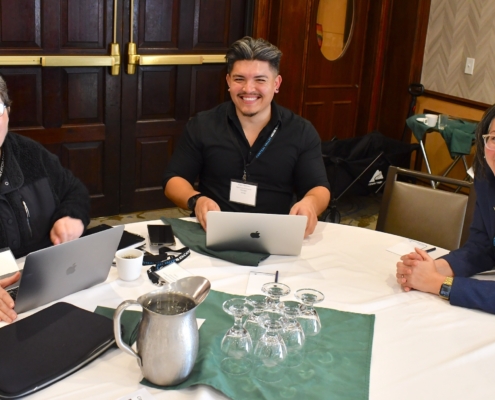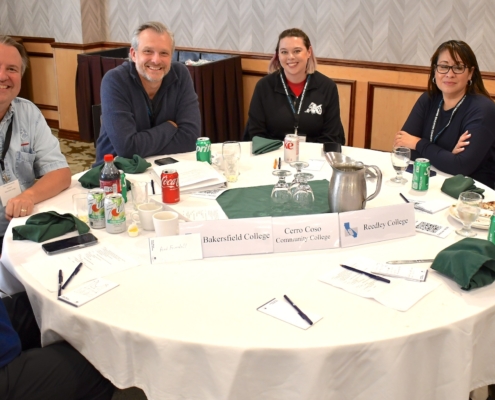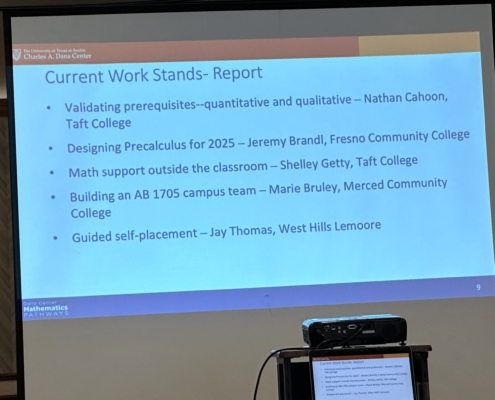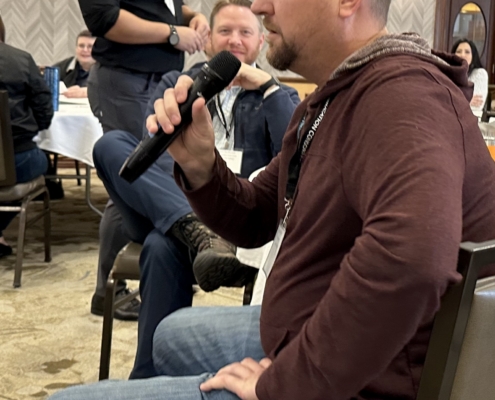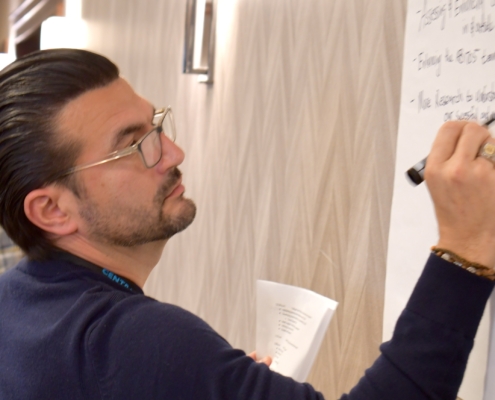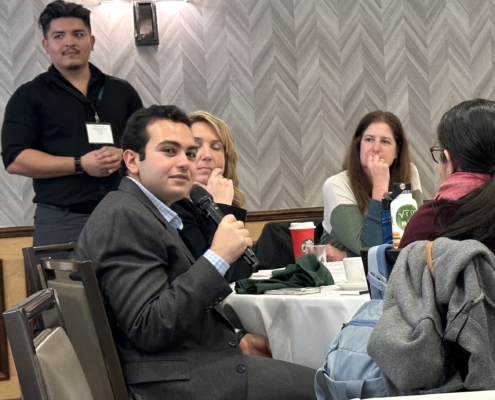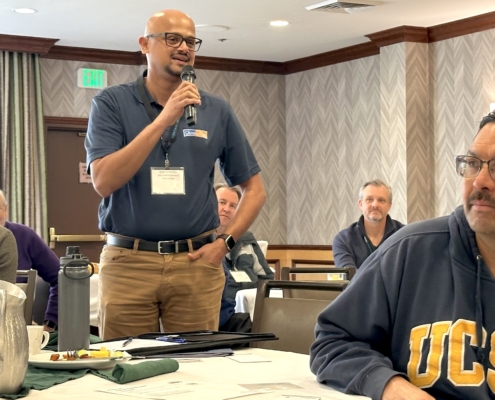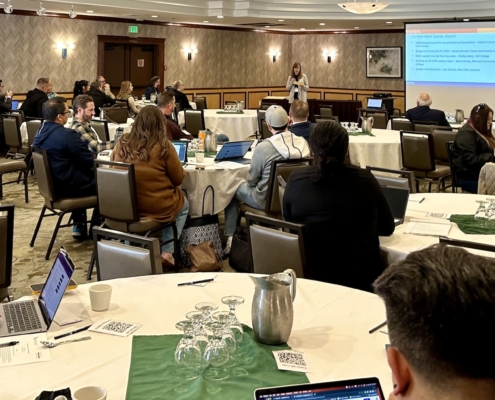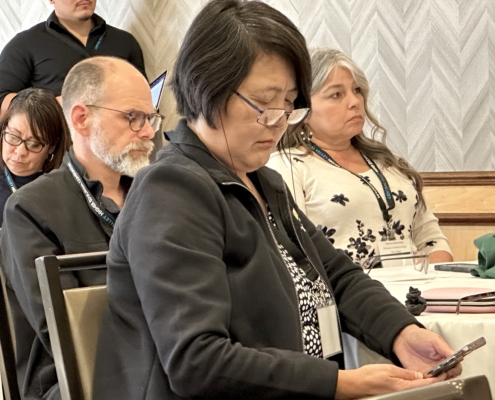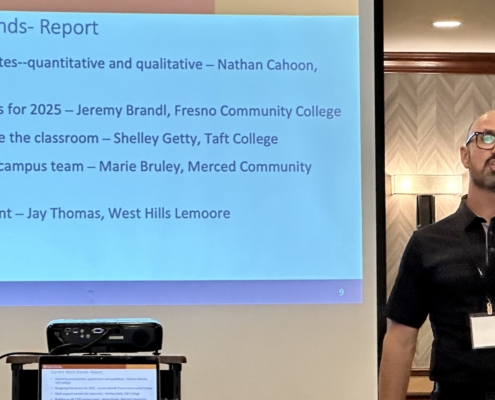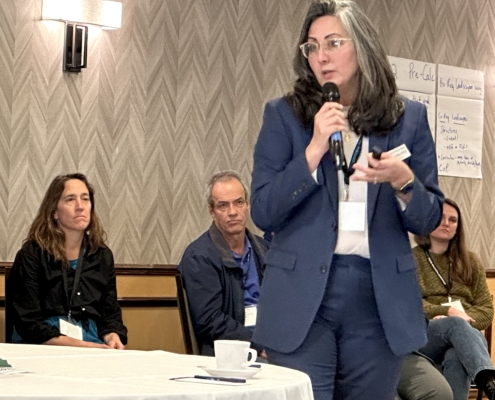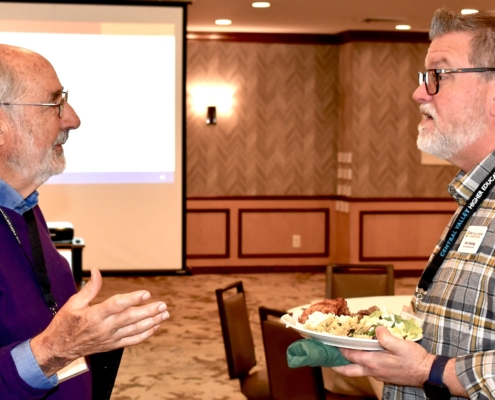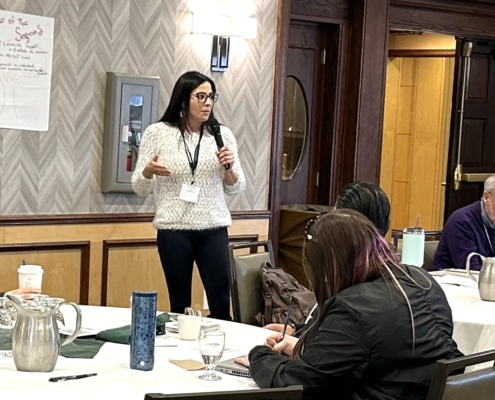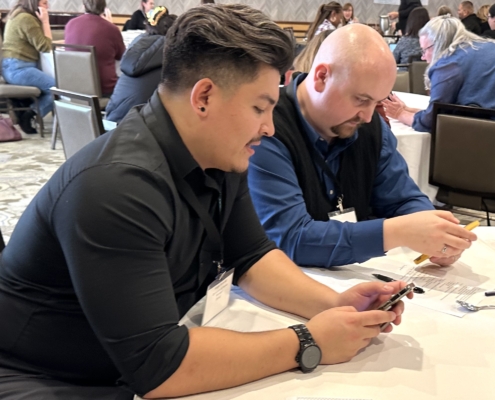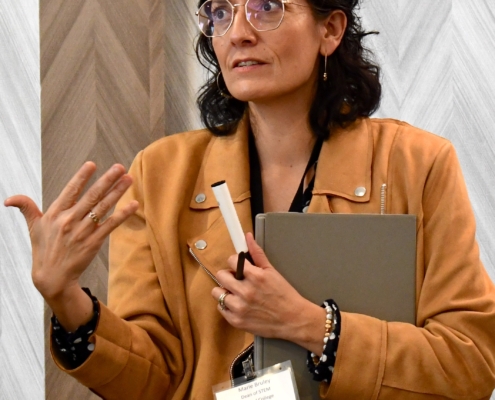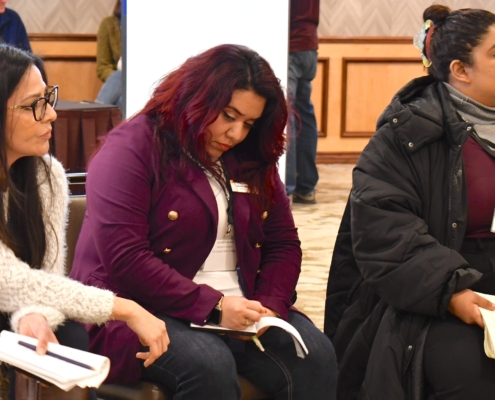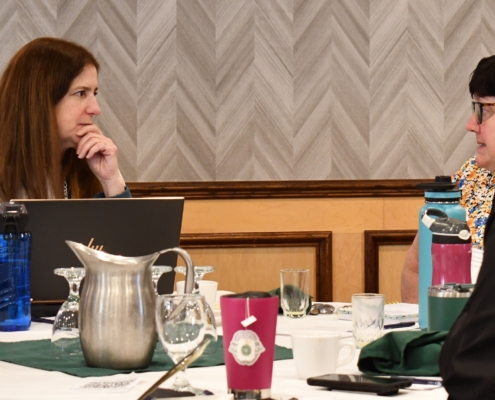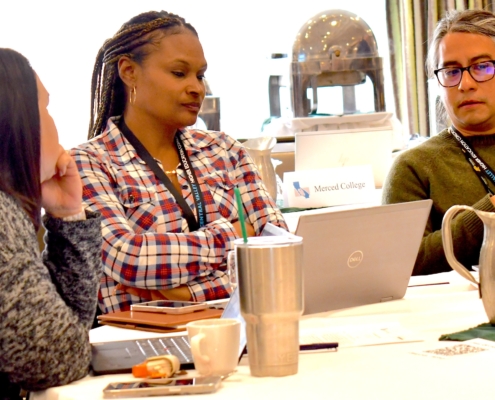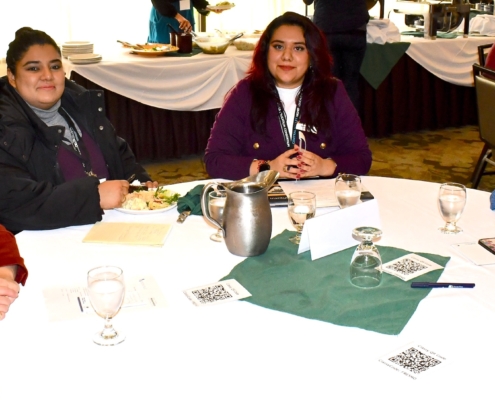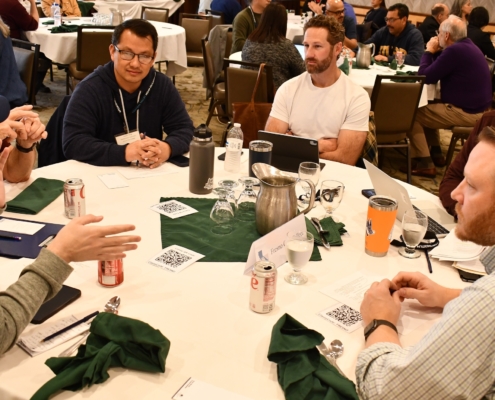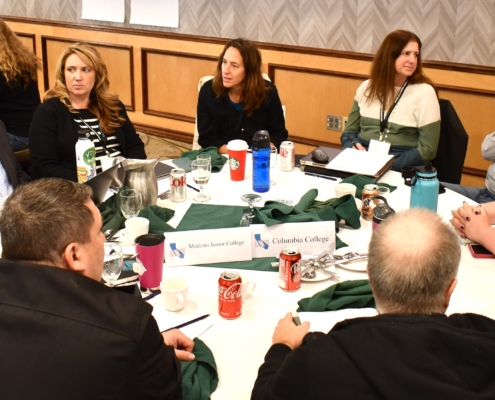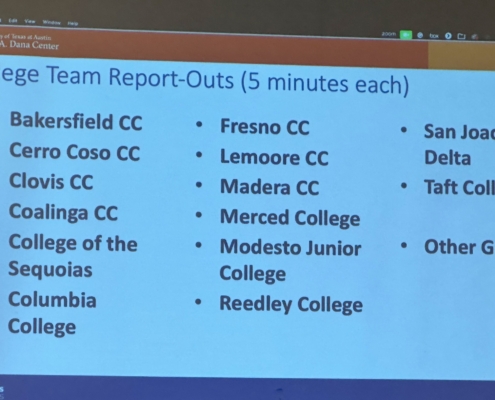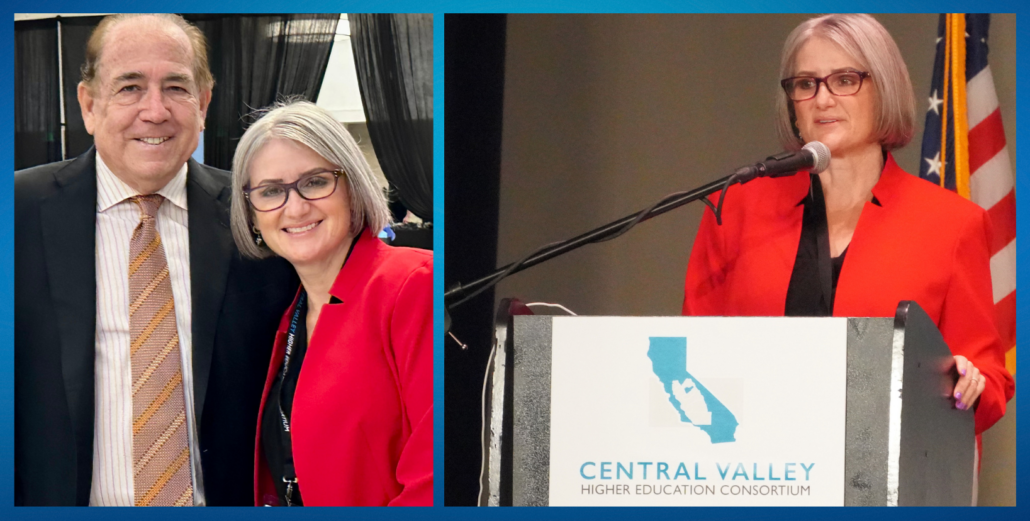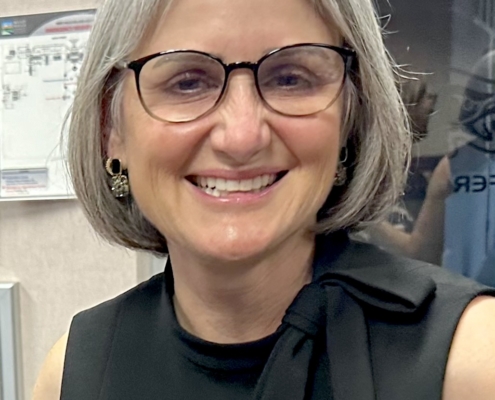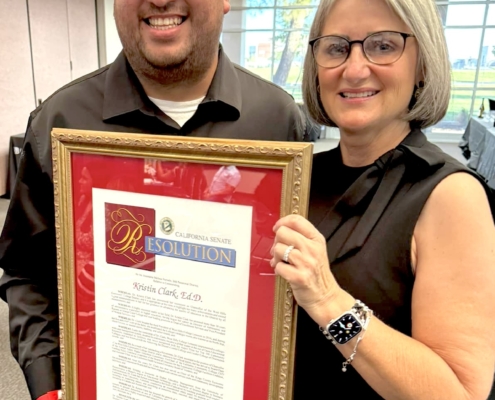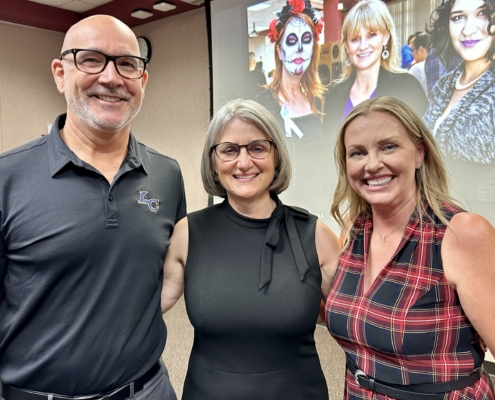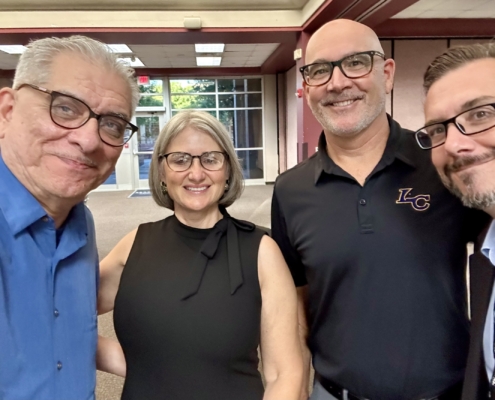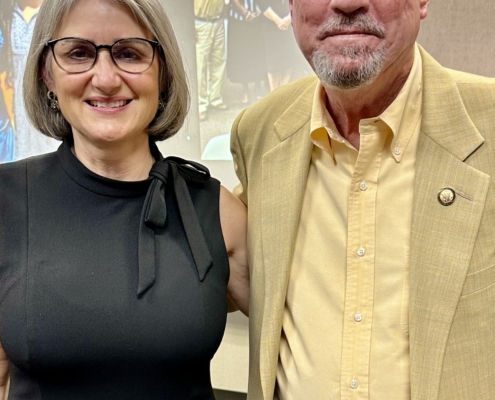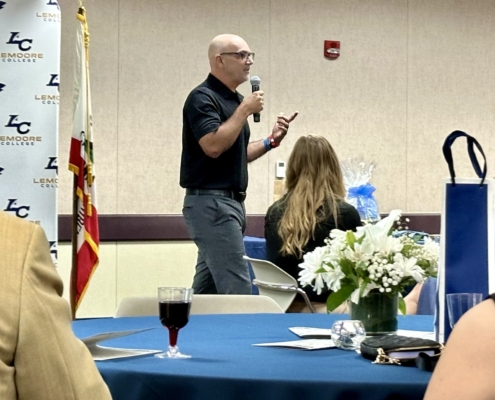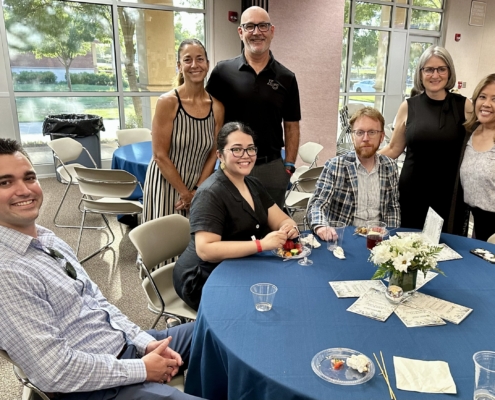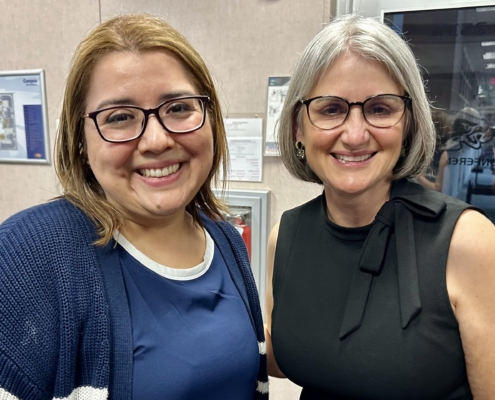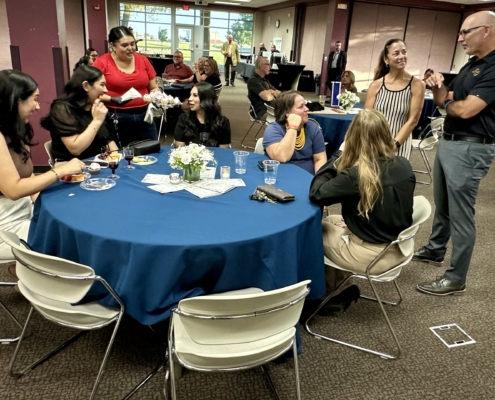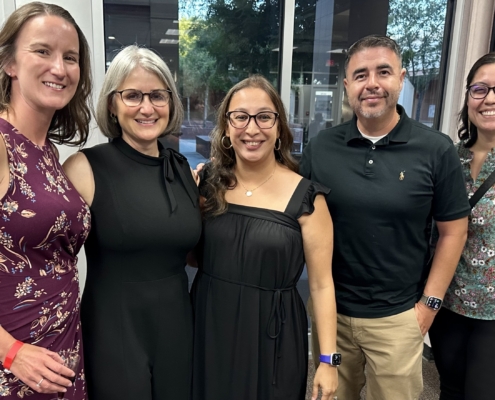This month’s “What The CV-HEC Is Happening” Blog takes a unique look at an unprecedented wave of leadership at five major Kern County education institutions: California State University, Bakersfield; Kern […]
Secondary education voices invited to join discussion Discussions to improve calculus pathways for STEM students amidst a pending deadline this summer continues with the third “Central Valley Way to AB1705 […]

Priscila Villanueva at the 2023 CVHEC Summit with Angel Ramirez and two student panelists, Hailee Guerra (left) and Jesús López Nuñez (right).
This issue brings another melancholy moment as we bid farewell to a key star of the Central Valley Higher Education Consortium team, Priscila Villanueva, our administrative coordinator since 2018.
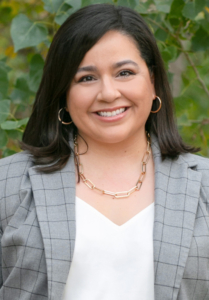 Priscila will start a new position as community associate for Equitable Bank Standards, Beneficial State Foundation supporting community engagement for the Equitable Bank Standards initiative.
Priscila will start a new position as community associate for Equitable Bank Standards, Beneficial State Foundation supporting community engagement for the Equitable Bank Standards initiative.
She has been instrumental in CVHEC’s mission with a focus on increasing educational equity in the Central San Joaquin Valley, said Dr. Benjamín Durán, CVHEC executive director.
“Priscila became an important part of our CVHEC family and will be dearly missed,” Durán said. “Her dedication and commitment to our mission was evident in all she did for us. We wish her and her family all the best.”
Ángel Ramírez, director of operations and finance and Priscila’s immediate supervisor, credited her with playing a major role in the consortium’s increased growth the past eight years.
“Priscila always took care of the everything behind the scenes that most people don’t get to see, but her role with CVHEC allowed us to run smoothly, efficiently, and worry-free these last eight years,” Ramírez said. “I am eager to see where this new position takes her.”
Priscila said that from day one, “Dr. Durán and Angel set the pace for a dynamic and collaborative team. I have been privileged to have had a front seat to the CVHEC initiatives and all the good CVHEC has done in the Central Valley.
“I cannot thank Dr. Duran and Angel Ramirez enough for their leadership, constant support, care and love. I leave CVHEC having built invaluable relationships and connections. I will treasure and miss my work and team, but I am excited to see where they go next!”
CVHEC has announced a job search to fill the position as soon as possible, Ramirez said.
See Application.
Modesto Junior College math professor Tina Akers-Porter discusses her strand group’s deliberations at “The Central Valley Way to AB1705 Success” Convening Jan. 26 where a call for a “principals task force” by Orosi High School Principal Marlena Celaya would bring more secondary education voices to the table.
‘Something extraordinary is happening in math in California’s Central Valley’
Math Task Force latest AB1705 session leads to calls
for more data, high school input, re-convene April 19
BY TOM URIBES
CVHEC Media/Communications Coordinator
Realizing that state guidance surrounding Assembly Bill 1705 remains elusive, valley community college math educators and officials forged ahead at “The Central Valley Way to AB1705 Success” convening Jan. 26 in Fresno with a determined and unified mindset to develop implementation plans that will serve the best interests of their students including a follow-up session set for April.
In addition, the Central Valley Higher Education Consortium (CVHEC) Math Task Force discussion centered around five strands of curriculum planning for implementation before the law goes into effect July 1, two aspects emerged at the lively day-long work session: the increased participation of institutional researchers for pertinent data-collecting and a call for a “principal’s task force” to bring upper secondary education voices to the table.
Presented by CVHEC, the convening — the latest in a series of deliberations since fall — was attended by 82 representatives from the consortium’s 19-member community colleges, one high school principal and campus research professionals.
They agreed to reconvene April 19 for reports on follow-up work that will occur as a result of this most recent event. Registration for that event will open next month with additional details forthcoming.
Facilitated by the Charles A. Dana Center at the University of Texas at Austin, the session last month reviewed five strands of curriculum planning: Validating Prerequisites; Designing Precalculus for 2025; Math Support Outside and Inside the Classroom; Building an AB 1705 Campus Team; and Guided Self-Placement.
“With tensions high and little guidance surrounding AB1705, the 19 community colleges and districts that comprise the CVHEC nine-county region are rolling up their sleeves and getting to work on this math movement the ‘Central Valley Way’,” summarized Tammi Perez-Rice of the Dana Center.
Perez-Rice, who co-facilitated the event, said the convening was solely dedicated to working and planning at a regional and institutional level in two parts. The first part was dedicated to expanding the five work groups that emerged from the Nov. 17 webinar and creating a plan to move forward. The second half of the convening was devoted to institutional planning.
“The fruits produced from these convenings are already being felt around the region,” Perez-Rice said. “The plans and implementations emerging from these convenings are more than just a response to AB705 and AB1705; they cultivate systemic reforms that will benefit all students in the CVHEC region and beyond.”
John Spevak, CVHEC regional coordinator who oversees the consortium’s Math Task Force and co-facilitator of the Jan. 26 gathering, said in the short-term, the five strands work groups will continue to communicate and provide updates in preparation for the April 19 convening. The strand leads are preparing summaries of their Jan. 26 breakout discussions and member college teams are preparing summaries of the tentative plans they developed in the afternoon breakout sessions for oral reports in April.
“In the longer term, our Math Task Force will continue to monitor what the California Community College Chancellor’s Office says, while mainly going forward with our own Central Valley approach to the five strands.”
That “Central Valley Way” stems from the work undertaken by the CVHEC Math task Force, first formed in 2019, in the past year that was intensified with four work sessions beginning Oct. 6 in a virtual convening with CCC vice-chancellor Eric Cooper. The first in-person session followed Oct. 13 in Fresno and another virtual session was held in two parts Nov. 17 before the Jan. 26 session.
These sessions may represent the only concerted effort by a region’s community college math community actively meeting to collaborate across campus boundaries for ways to unite as one voice and determine a curriculum course of action that meets the law’s intent, Spevak said.
“We at CVHEC, along with the Dana Center representatives and our College Bridge partners in the Math Bridge Program, feel that something extraordinary is happening in math in the Central Valley of California,” Spevak said.
After the Jan. 26 session ended, Perez-Rice reiterated a point she made the first time she visited Fresno for the first in-person convening last fall:
“This collaboration today was amazing. As I travel and talk to math faculty all over the country, what I see pulsating from the CVHEC community here in Central California is just compassion; caring about their students; putting their students first; understanding what their students need; and more importantly collaborating with each other working across institutions to make things happen.”
Inviting secondary ed voices to ‘align syllabi’
A key development of the convening was the assertion and agreement that a crucial next step is “to involve high schools in the discussion and determine how to breakdown barriers between systems for a cohesive collaborative effort to put students first across the state of California,” a message delivered by Marlena Celaya, principal of Orosi High School who was the only secondary education official in attendance.
Celaya’s comments, first in a strand session and later in general comments before the assembled group, resonated with the community college professionals as she offered to lead a task force of principals/administrators who would unify with the CVHEC community college math educators for implementation strategy — to listen and hear what the needs are and how to meet those needs.
“I’m willing to lead this work because I don’t want people to go through the wars I went through teaching algebra and volunteering all my time,” said Celaya, a former math teacher at Dinuba High School. “We would want to hear from community colleges and say to them ‘what do you need?’
“We heard something from you today: ‘I want to know what courses are offered at the high school and what does that course description look like?’ Aligning syllabi is what I’d like to do,” Celaya said. “Mathematics is my passion.”
Perez-Rice said the April 19 convening promises more high school representation, with over twelve principals who are part of the Math Bridge Program by CVHEC and College Bridge being invited. Other secondary education officials from throughout the valley are welcome she said.
Participant feedback: ‘great to see we’re not alone in this …’
After the event, several participants shared their assessment of the Jan. 26 convening.
“The conversations were amazing and we really appreciated being here,” said Joshua Lewis, chair of the Bakersfield College Mathematics Dept.
“There have been so many legislative changes and so many unknowns it’s nice to see the work that other campuses are doing and realize that we’re not alone, that we have shared values; that we have shared emphasis on student learning and really care about doing right by all of our students,” he added.
Nathan Cahoon, Taft college math professor, felt that the efforts of CVHEC’s Math Task Force as exhibited at the convening is strengthening the voice of the valley’s math community which will have an impact.
“It was amazing to work with incredible professionals who have some really amazing ideas,” he said. “I know I took many good notes about ideas to implement at our college. The connections we are building here with each other will be powerful down the road as we build a cohesive effort to get some good research together that we can send to the state as one voice from all the colleges.”
Modesto Junior College math professor Marina Hernandez said coming together within the region is relished because when attending other statewide or national conferences, the focus is not as localized.
“It was very helpful to learn what other colleges in the Central Valley are doing because we share similar student population and resources characteristics and their best practices are applicable to us here in our region,” Hernandez said.
Tina Akers-Porter, Modesto Junior College math professor, said the Math Task Force work has helped her better understand what AB1705 is and what it means for her students.
“I feel like I have a better understanding of some of the challenges of the legislation and what others are worried about,” she said. “We share some of those worries but it’s great to hear different points of view on that. A byproduct of this is we are seeing how we need to support underprepared students more, inside and outside the classroom, and sharing ideas to do that.”
Shelly Getty, Taft college math faculty and a strand leader, echoed Akers-Porter: “We left knowing we are going to start some specific tutoring and targeting students for tutoring. We will try to advertise it better and recruit so students get more access to the services we already provide which will greatly impact them. We shared some good ideas on how to do that effectively.”
Marissa Martinez, Taft college math professor, said, “We have our work cut out for us. There’s a lot of things that we have to address with a lot of moving parts. Everything keeps changing but it was great to be able to see that we’re not alone in this, that we’re working together to better serve our students.”
She said this intercollegial collaboration and the feedback from the colleges helps “so we don’t have to reinvent the wheel — what worked, what didn’t work.”
Next steps? Data research
“I would say the next step is collecting our data to see how the numbers show where we are so we can prove that these courses are important for our student success,” Martinez said.
This data aspect was also a key part of the convening as institutional research professionals were invited and directly participated such as Arooj Rizvi, research analyst in the Office of Institutional research and Effectiveness at San Joaquin Delta College.
“Researchers have a monumental role in the implementation of AB 1705 because policymakers are going to depend a lot on what we are able to produce as a group or even as an institution,” Rizvi said. “Being a part of these conversations helps us to see the bigger picture, the context and the requirements of what exactly it is that we are looking for in the data.”
She said it was exciting to hear at the convening what area colleges are going through.
“I realized how similar our challenges are from institution to institution, “she said. “Working through that together and being solution-oriented is something that’s going to take all of us towards a beneficial direction. Seeing us all here today was a defining moment in history.”
Owynn Lancaster, vice president of academic strategy for CVHEC partner College Bridge, said the event was “a huge success seeing folks come together from math to talk about math and really pool their resources to address actual challenges.
“The most powerful focus of change in education is always the educator,” Lancaster said. “I know everything’s heaped on them but in a lot of ways they have the greatest power of the greatest agency for this.”
For more info: centralvalleyhec@gmail.com
For CVHEC media inquiries: Tom Uribes – cvheccommunications@mail.fresnostate.edu (or text 559.348.3278).
See also:
https://bit.ly/MTFconveneKSEE24
Valley’s math ed experts unite to address AB 1705 challenge for student success
The CVHEC Way to Math Success — Implementing AB1705
Math Task Force begins discussion of AB1705 implementation – Nov. 17 next
CVHEC Math Task Force meets in-person Oct. 13 for AB 1705 follow-up
NEWS RELEASE – CVHEC Math Task Force: Impactful legislation (AB 1705) Convenings Oct. 6 & 13
CVHEC Website Feature: Math Task Force Page
PHOTO GALLERY
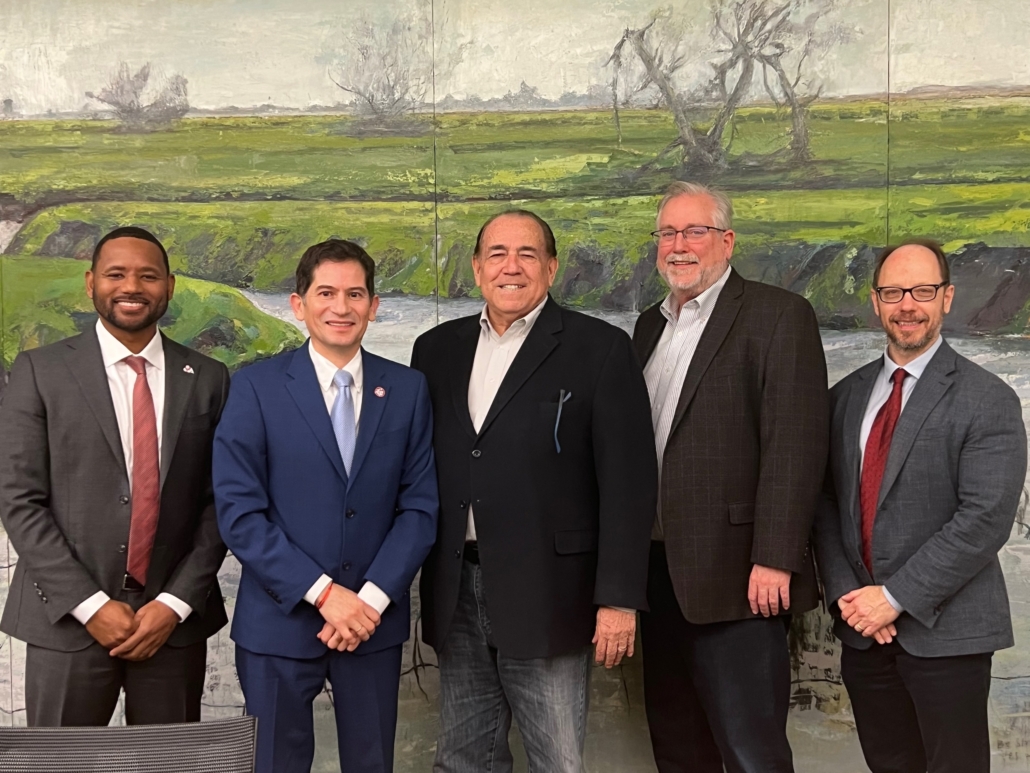
Fresno State, a founding CVHEC member, joined CVHEC’s historic Central Valley Transfer Project in January with (from left): Dr. Kent Willis, vice president of Fresno State Student Affairs and Enrollment Management; University President Saúl Jiménez-Sandoval; Dr. Benjamin Duran, CVHEC executive director; Tom Burke, CVHEC regional coordinator; and Dr. Sergio La Porta, associate dean of the Fresno State College of Arts and Humanities.
Fresno State joins in transfer ‘centerpiece’ with
11 CVHEC community colleges, 3 CSUs, UCMerced
The Central Valley Transfer Project is now partnered with the region’s three California State University campuses after Fresno State signed on in January joining Bakersfield and Stanislaus in the historic Central Valley Higher Education Consortium initiative designed to open new doors for students’ successful transfer from community college.
Along with founding partner University of California, Merced, this means the valley’s four public institutions of higher education are working in unison with 8 community colleges currently through CVHEC’s project using the groundbreaking Program Pathways Mapper software. The project has also gained the full support of the California Community College Chancellor’s Office.
The community colleges already in the CVTP, with several more expected to sign on this year, are: Bakersfield College, Clovis Community College, Madera Community College, Merced College, Porterville College, Reedley College, West Hills College-Coalinga and West Hills College-Lemoore.
The Transfer Project is also expanding participation in the north end of the Central Valley with Modesto Junior College, Columbia College and San Joaquin Delta College scheduled to begin onboard this spring for a total of 11 community college partners said Stan Carrizosa, CVHEC regional coordinator and consortium lead for the project.
All Transfer Project partners are members of the consortium with their respective chancellors and presidents serving on the CVHEC Board of Directors.
“The Transfer Project is now a centerpiece for students to both enter and transfer from community college to their four-year universities,” said Dr. Benjamín Durán, CVHEC executive director. “We are excited to share this latest progress of the project which has been featured statewide and nationally at conferences such as the Community College League of California and Complete College America.”
He added, “This innovative approach is the only one in the state that includes a University of California campus collaborating with partner California State University and community colleges in establishing transfer pathways for Central Valley students to get them to and through college in a timely manner.”
Dr. Saúl Jiménez-Sandoval, Fresno State president and CVHEC board member, said, “I’m proud that Fresno State will be a dynamic partner in the Central Valley Transfer Project, as this pathway will empower community college students to become visionary Bulldogs.”
The Fresno State agreement was finalized Jan. 17 between Durán and President Jiménez-Sandoval, with Tom Burke, CVHEC regional coordinator and Transfer Project team member; Dr. Kent Willis, vice president of Enrollment Services; and Dr. Sergio LaPorta, associate dean of the College of Arts and Humanities.
At CVHEC’s Higher Education Summit last fall, CCC Chancellor Sonya Christian announced that the statewide system has designated the Transfer Project as a demonstration project as set forth in her Vision 2030 for all California community colleges. The Transfer Project’s participating community colleges are serving as the pilot campuses with plans to implement statewide.
Carrizosa said the state budget continues to support and fund the onboarding costs for all community colleges to subscribe to the Program Pathways Mapper.
Established in 2021 with UC Merced, Merced College and Bakersfield College, the project is designed to open new doors for students to successfully transfer from community college with its Program Pathways Mapper, Carrizosa said.
He said the Program Pathways Mapper — a public facing, internet-based app that can be downloaded and accessed by the public software platform — provides unprecedented ease of access for students, counselors, advisors and parents much more so than other existing platforms.
“There are no typical requirements for access to PPM such as other internal college systems like Degree Works, Assist.Org and the CSU Transfer Planner,” he said. “These are all course tracking systems but in order to use them, students need to be successfully enrolled in college and have a student email address or other form of login to try and plan. Through PPM students simply upload the public PPM app to their devices and have immediate access.”
Carrizosa said the PPM helps simplify the transfer planning process which can be the most difficult task for many students.
“In much of our Central Valley region, as many as seven out of 10 incoming college freshmen will be first generation students to attend college,” he said. “Research shows that the most difficult task for them is often the application process itself and completing the required steps for enrollment. Systems like Degree Works and others do nothing to remove this common barrier because these systems cannot be accessed until a student successfully enrolls.”
He explained that a high school student can start the Transfer Project journey as a junior or senior by enrolling in college dual enrollment courses enabling them to complete their transfer level English and Math courses while still in high school. These units roll up with them as they enter community college and track the completion of their lower division requirements for their Associate Degree for Transfer in their chosen major via PPM.
“Students can easily select a community college they wish to attend and a major they want to pursue and the lower division courses required are sequentially laid out for them through the Program Pathways Mapper software.”
In addition, the PPM then links those lower division courses to an upper division institution of the student’s choice and shows a clear sequence of upper division courses needed to complete the degree, Carrizosa added.
“The PPM contains clear and accurate information directly from course catalogues from all participating colleges,” Carrizosa said. “The Central Valley Transfer Project is becoming an alternative continuum of courses to the traditional high school A-G or Career Technical Education continuums and is unprecedented in the state’s community college system. We call it ‘The Central Valley Way!’”
“Through the use of PPM, students complete exactly what is required of them to successfully transfer to their four-year university and they follow PPM through their last two years to degree/certificate completion,” Carrizosa said.
Baseline data results also demonstrate the promise that PPM delivers in the Transfer Project.
In a sample of 5,000 incoming freshmen to Bakersfield College in 2022 the students using the PPM increased their “percentage of on-path course completion” to over 80 percent which also closed the equity gap in this statistic for ethnic minority students when compared to their white counterparts, Carrizosa said.
“The same sample showed students using the PPM reduced the ‘number of units-to-degree’ from an average of 87 down to 67,” he added.
The project is now gearing up to expand the partnership with the College Bridge Math Project and to onboard community colleges from the northern region of the Central Valley.
For more information about the CVTP, contact Carrizosa at centralvalleyhec@gmail.com.
CVHEC media inquiries: Tom Uribes – cvheccommunications@mail.fresnostate.edu or text 559.348.3278.
Fresno State media inquiries: PIO Lisa Bell – lbell@csufresno.edu.
See:
· Pilot CVHEC/UC Merced Transfer Project improves process for students
· CVHEC Web Site Feature: Transfer Project
· Historic Transfer Project spurs statewide movement to increase transfer rates
· HIGHER ED NEWS: College Bridge to expand Math Bridge; CVHEC Transfer Project
• A-G

Ángel Ramírez (right) represented CVHEC in the Central Valley Community Foundation delegation of area leaders attending the Achieving the Dream Conference in Orlando Feb. 19-22 (from left): Carlos Castillo; Phong Yang; Estefania Avalos Chavez; Vianey Barraza Chavez; Julie Vue; Ángel. Not in picture: SCCCD Chancellor Carole Goldsmith.
The Central Valley Higher Education Consortium is participating this week in the 20th anniversary convening of DREAM, which brings together thousands of practitioners from hundreds of colleges “to exchange evidence-based approaches to accelerating student success in a manner that champions equity and drives economic vibrancy.”
Ángel Ramírez, director of operations and finance, is representing CVHEC in the Central Valley Community Foundation delegation of area leaders led by Julie Vue, CVCF senior program officer, attending the four-day event in Orlando, Florida
Other CVCF delegation representatives are Carlos Castillo, chief of Diversity, Equity, and Inclusion at Fresno Unified School District; Phong Yang, associate vice president for Strategic Enrollment Management at Fresno State; Estefania Avalos Chavez, board member, Higher Education For All; Vianey Barraza Chavez, director of Education Programs and Special Projects for the Education and Leadership Foundation; and Dr. Carole Goldsmith, State Center Community College District chancellor who also led a SCCCD delegation to the conference.
The conference is presented by Achieving the Dream, a national organization of more than 300 community colleges across the country partnering to build customized growth plans to address the unique challenges each institution faces.
It embodies Achieving the Dream’s longstanding belief in advancing community colleges as accessible hubs of learning, credentialing and social mobility that eliminate inequities in students’ educational and workforce outcomes.
Through plenary sessions with critically acclaimed scholars, educators, and activists and breakout sessions with higher education thought leaders at the Orlando gathering, a nationwide network of colleagues are sharing 20 years’ worth of lessons learned in the student success field and promoting a vision of higher education as an engine for equity and a catalyst for community transformation.
The Central Valley Community Foundation, the only accredited community foundation in the region, drives strategic investments and offers best-in-class charitable tools to connect donors to the causes they care most about with $140 Million in assets under management.
Central Valley Higher Education Consortium Executive Director Benjamin Duran and Orosi High School Principal Marlene Celaya discussed the Jan. 26 “Central Valley Way To AB1705 Success” Convening with Emily Erwin on the KSEE24 Central Valley Today live on Jan. 23: https://bit.ly/CVHEC-MathTFJan26-KSEECVT012324
Dr. Duran presented the CVHEC Math Task Force work of the past few months leading up to the Jan. 26 covening in Fresno of math professionals collaborating on implementation of AB1705. Principal Celaya, a former Dinuba High School math teacher, articulated the perspective of the secondary segment of education and the impact on high school students. The task force meets again April 19 in a diligent effort for compliance when the law goes into effect July 1.
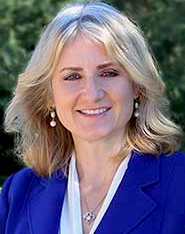 The West Hills Community College District (WHCCD), announced today the retirement of Chancellor Dr. Kristin Clark effective July 2024. For the past two years, Chancellor Clark has served as chair of the Central Valley Higher Education Consortium Board of Directors, which is made up of the chancellors, presidents and campus directors of 28 institutions of higher education in the region’s nine-county area. She also served on the board during her term as president of West Hills College Lemoore prior to the WHCCD chancellorship. The West Hills Community College District will soon initiate a search for a new chancellor. Dr. Benjamín Durán, CVHEC executive director, issued the following statement.
The West Hills Community College District (WHCCD), announced today the retirement of Chancellor Dr. Kristin Clark effective July 2024. For the past two years, Chancellor Clark has served as chair of the Central Valley Higher Education Consortium Board of Directors, which is made up of the chancellors, presidents and campus directors of 28 institutions of higher education in the region’s nine-county area. She also served on the board during her term as president of West Hills College Lemoore prior to the WHCCD chancellorship. The West Hills Community College District will soon initiate a search for a new chancellor. Dr. Benjamín Durán, CVHEC executive director, issued the following statement.
Dr. Benjamín Durán, CVHEC executive director, and WHCCD Chancellor Kristin Clark at the Central Valley Higher Education Summit October 19, 2023 where she delivered the welcome address.
UPDATE July 26, 2024: Chancellor Clark honored at farewell reception (see photo gallery below).
STATEMENT
Chancellor Clark: a champion
of higher education for all
We at the Central Valley Higher Education Consortium along with so many others in the region and the state, are experiencing mixed feelings with Chancellor Kristin Clark’s announcement of her retirement effective the end of this academic year.
We are happy for Chancellor Clark as she completes a stellar academic career this spring in preparation for her retirement but at the same time we are saddened that the Central Valley region is losing a leader of her caliber. As the chair of the 28-member CVHEC Board of Directors the last two years, Chancellor Clark has been a champion of higher education for all and certainly for the initiatives and projects the Consortium has undertaken. She has been instrumental in building our network of Central Valley college and university leaders to speak in a single voice on higher education policy issues.
Additionally, Chancellor Clark is recognized throughout the state as the leader of one of the most innovative and student-centered multi-college districts in rural California. The West Hills Community College District and the communities it serves have been fortunate to receive her professional and personal leadership.
Please join us in wishing Dr. Clark all the best, as she gets ready to explore the next phase of her life. Well done, Kristin!
Benjamín Durán, Ed.D.
Executive Director – The Central Valley Higher Education Consortium
President-emeritus – Merced College
See the WHCCD retirement announcement press release.
Bio – Chancellor Kristin Clark

